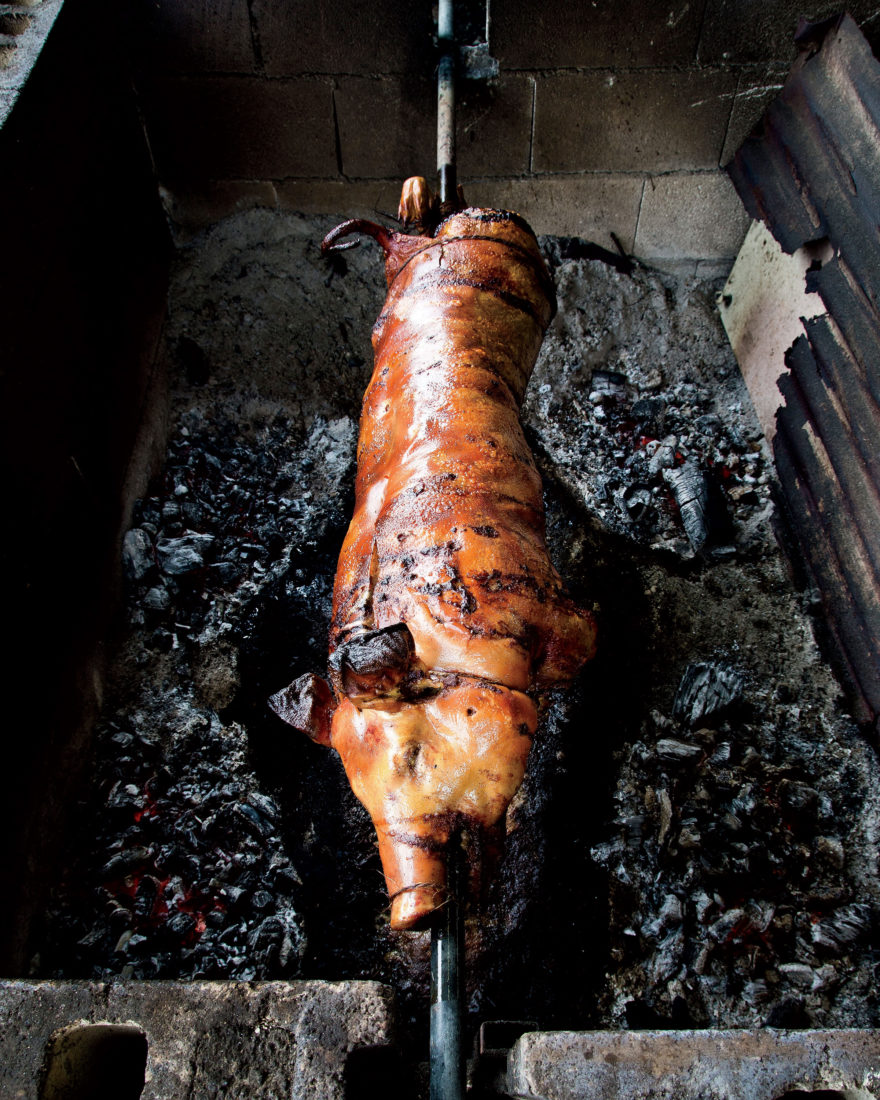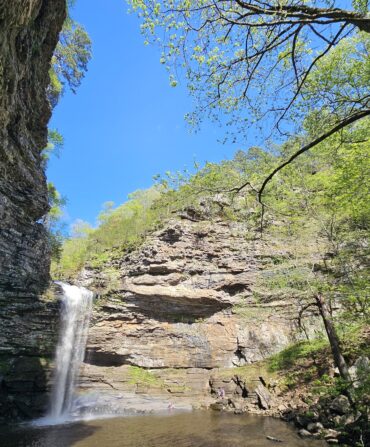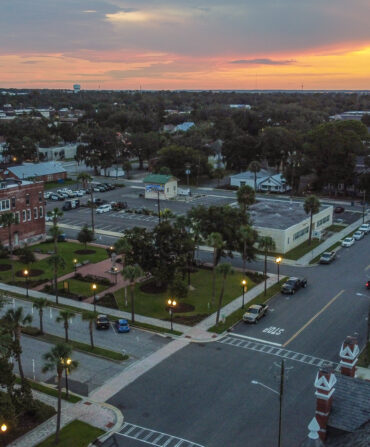The call comes as we bank a narrow blacktop and snake up the mountain, through a green steeple of teetering bamboo, pine, and palm. Women line the highway, selling buckets of honey and bags of oranges from pickup tailgates. Beneath jerry-rigged ramadas, men fry plantain-wrapped and picadillo-stuffed pastries called piononos in wood-fired kettles, set in disemboweled oil drums. Jeeps whip past, tops down, blasting reggaeton through roll-bar-mounted speakers.
We are twenty miles south of San Juan, Puerto Rico. Pedro Alvarez, a full-time local chef and part-time local sausage maker, is at the wheel. His girlfriend, Liza Berrios—whom I met two nights before while drinking coconut-infused bootleg rum at a bay-front party, and who agreed, on a whim, to take me on a lechón quest—drives another car, loaded with friends and a cooler of drinks.
I ride shotgun with Pedro and fret. Based on the end of the conversation that I can hear, Apa Ramos, the revered lechonero we plan to visit on this sunny Saturday afternoon, is out of pork. Or nearly out of pork. Toward the close of the conversation, Pedro uses the word cachete, and he motions with his phone toward his cheek. This I understand. There is a possibility that, when we arrive at Lechonera La Ranchera, the low-slung barbecue joint and sports bar run by Ramos, we may get to pick over the remaining charcoal-roasted pig carcasses for cheek meat.
Pedro shifts into second gear. Liza swings in behind. And we accelerate, through the peaks and valleys that ring San Juan, bound for a subtropical barbecue paradise.
Good barbecue in Puerto Rico looks, smells, and tastes a lot like good barbecue in the American South. Pig is the meat of choice. Lechoneros, the Puerto Rican equivalent of pit masters, do their work at humble cafés and roadside stands, reachable by switchback roads that thread the countryside. The best practitioners rely on a maximum amount of smoke. And a minimum amount of folderol.

Photo: Peter Frank Edwards
Apa Ramos outside the cook shed at Lechonera La Ranchera.
Those kinships came into focus at our first stop of the day, Lechonera Moncho, an open-air hutch near the village of Guaynabo. Like his father before him, Ramón Sanchez smears gutted and twine-rolled pigs with a mix of salt, pepper, garlic, and oregano. And he cooks those pigs over hardwood charcoal. Order a pound of pork, and Sanchez will reach beneath the counter for a lead pipe and a long cutlass to whack through bone and sinew and free your prize.
Much of what I saw and tasted at Moncho was familiar. When we asked to see the pits, Sanchez led me behind the restaurant, through a barnyard, to a shed where two cinder-block constructions hunkered and a hillock of charcoal smoldered. We could have been in South Alabama. Or central Georgia, where I grew up.

Photo: Peter Frank Edwards
Paradise of Pork
Pork, rice, and morcilla sausage at Lechonera Moncho.
But differences came into focus at Moncho, too. When I took a closer look at the pits, I discovered that each is rigged with a small engine and gear chain. Flip a switch and the rig flips the pig in one-minute rotations, a labor-saving innovation that many American traditionalists might dismiss as the first step toward machine-made barbecue.
Instead of dishing potato salad and coleslaw, Sanchez serves bowls of rice and peas. Instead of cooking down hash or stew with pork oddments, he stuffs lengths of pig intestine with a creamy mix of pig neck meat and rice to make a ferrous-tasting sausage called morcilla.
Throughout my time in Puerto Rico, though, the commonalities stuck with me. And so did the backstories. As I traced the roots of the word barbecue, and of the men who first practiced the craft, I confronted tales of the Taíno. Native people who were living in Puerto Rico when Spanish settlers arrived, the Taíno most likely built the first frameworks of sticks to smoke-roast meats, honing a technique we now know as barbecue.
Tracing the cultural exchanges that gave rise to today’s lechón, I learned that, just as enslaved Africans worked the rice, cane, and cotton fields of the mainland United States, Africans worked the cane fields of what is now Puerto Rico. They left their culinary imprint here, too, through lechón side dishes such as pasteles, which translate as banana dough, stuffed with pork, steamed in banana leaves.

Photo: Peter Frank Edwards
Pork-stuffed pasteles in banana leaves.
In the United States, too many barbecue joints now turn on the gas when no one is looking. They fan grease smoke toward the street like a false promise. Bad barbecue abounds in Puerto Rico, too. That becomes clear when, after stops at gas-fired operations—where drinking seems to be the activity of choice and not a tendril of smoke curls skyward from the pits—we arrive at the hilltop village of Guavate.
Saturday afternoon in Guavate is a scene. A dozen or more lechoneros run dine-and-dance joints for day-tripping San Juan residents. From the bandstand at La Reliquia, a five-piece brass-and-bongos act plays salsa riffs on Sinatra’s “My Way.” At the roadhouse restaurant known as Los Pinos, college students seated at trestle tables play drinking games and shriek like banshees.
The Puerto Rican government promotes the road that wends to Guavate as the Ruta del Lechón—the Road of Pork. To that end, the food at Los Pinos isn’t bad. The steam table bobs with funky offal stews, and planks of crisp skin, carved from cordovan-hued pigs, come with each order of hacked pork. Drink a couple of mojitos, muddled with rhum agricole and mint, and all compromises are forgiven.
That said, if you have ever tasted whole hog cooked over hardwood at Skylight Inn in Ayden, North Carolina, or B. E. Scott’s in Lexington, Tennessee, you will recognize that the hog cooked over gas and pulled from Guavate carcasses has as much in common with honest lechón as butterscotch-flavored Jell-O has with dulce de leche–draped flan. And you will do what Pedro and I do, soon after we get the call that our end-of-the-rainbow cache of wood-smoke-perfumed pig may soon be exhausted: Drive on.

Photo: Peter Frank Edwards
Dining at Los Pinos.
A decommissioned tractortrailer anchors the compound where Apa Ramos has cooked pigs and held court since 1985. The sports bar next door, with its stacks of speakers and wide-screen televisions, appears an aberration, redirected from a twenty-first-century future that still hovers on the horizon. In the cook shack, the floor is rough concrete. The pits are grease-stained feats of masonry engineering. Decades of calcified smoke shellac the timber and tin roof.
Ramos, a squat and taciturn man, greets our band of pilgrims at Lechonera La Ranchera with a shy smile. We’re not the first to make the trek. On the wall behind the cash box, alongside a Baptist church–issue portrait of Jesus among the little children, I spy an arm-in-arm picture of Ramos and Eric Ripert, the chef at Le Bernardin in New York City. In another glossy, he stands tall beside a smoke-lacquered pig at the Food & Wine Classic in Aspen.
Ramos plays the part of lechonero well. Leaning back in a metal folding chair, as a gray kitten weaves through his legs, he mumbles answers to my queries and brushes aside compliments. Liza and Pedro translate. To make charcoal, Ramos whispers, the best carboneros mound aromatic wood, harvested from the coast, into tepee shapes, cover them with hay and mud, light the mounds, and let them smolder for three days. To coax the most flavor from lechón, he sources pigs from local farmers.
Like other great barbecue artisans, Ramos talks a good sauce game. When I share my theory that vinegar-based sauces are ideal complements for smoked pig, he directs my attention to a repurposed rum bottle, filled with house-made pique criollo. A proper sauce for pig, Ramos tells me, as I turn that bottle in my hands, boasts a few chiles, a little vinegar—and a lot of water. Too much vinegar can mask the flavor of pork, he declares, while water-based sauces carry flavor.

Photo: Peter Frank Edwards
Live music at Los Pinos.
When a tinfoil-wrapped platter of pork appears, as if by legerdemain, we fall on it like wolves. Sauce splatters. Skin flies like shrapnel. And so do bones, none of which appear to be from cheeks. Five minutes later, we smile greasy smiles and pay our respects to Ramos. Belching smoke and talking smack about every other pretender to the lechón throne, we make our exit. And soon we’re driving down the mountain, back through that green steeple.
Later that night, at Jose Enrique, a mod bungalow restaurant in the Santurce neighborhood of San Juan, I crowd the bar with a throng of well-heeled gastronomes to eat silky veal brains, sautéed in brown butter. And shingles of grilled swordfish, topped with pineapple. And tostones, pounded from plantains into the shape of daisies, fried hard, salted lavishly, and served with grilled lengths of longaniza sausage that Pedro stuffed and cured.

Photo: Peter Frank Edwards
GG0513_F
A green canopy outside San Juan.
Pedro, who is the number-two chef here, has the night off. Liza has come too. We’re stuffed silly with pork and buzzed from three rounds of Scotch and coconut water. (Liza says it’s a local specialty, and I’m a sucker for local specialties.) Yet we continue to drink. We continue to eat. And we continue to smile greasy smiles.
I can’t speak for Pedro or Liza. But I think I know why. We’re not fueled by gluttony. We’re compelled by a mutual recognition that if we three can find common ground in great pit-cooked pork, and we three can easily connect the dots between the barbecue of my native American South and the lechón of their native Puerto Rico, then surely there are more similarities to be celebrated. And there’s no better way to begin those explorations of common cause than with good food and drink in hand.









